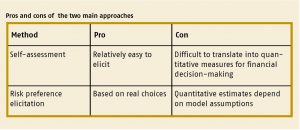An overview of methods measuring risk preferences
“To reliably measure risk preferences a mix of methods is recommended”
Based on research we recommend to pension providers that they use a mix of methods to measure risk preferences. It is important to be aware that any risk preference measurement may be prone to behavioral biases and systematic measurement errors.
In the new Dutch pension agreement, pension providers must invest in line with participants’ risk preference and they have to differentiate by age group. However, there are no established standards for obtaining this information. Both in practice and in academic research, a wide
variety of methods is used. Those methods include hypothetical survey questions and incentivized tasks with real consequences. Each method has its own pros and cons. Therefore it is important to understand the advantages and disadvantages of the various methods before choosing one method or a mix of methods.

Key Takeaways for the Industry
- To measure risk preferences, use a mix of carefully designed methods and econometric techniques.
- Account for known behavioral biases and mitigate systematic measurement biases.
- Risk aversion may increase with age although the evidence is inconclusive.


